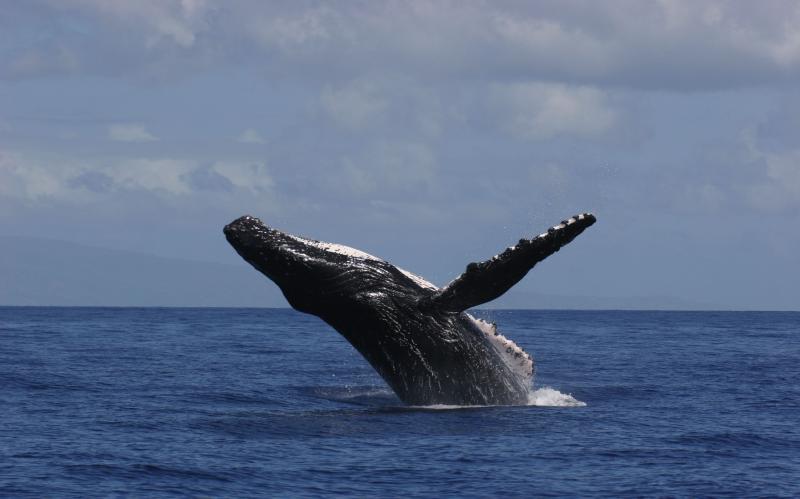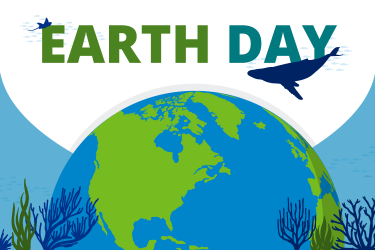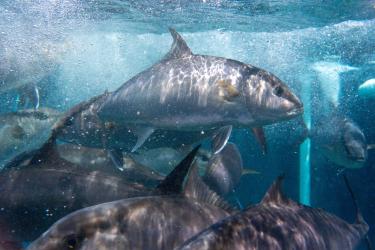The John H. Prescott Marine Mammal Rescue Assistance Grant Program provides funding to our National Marine Mammal Stranding and Entanglement Network partners. It allows them to better respond to marine mammal strandings, improve capacity, and conduct scientific investigations into the causes of stranding events. Since 2001, the program has awarded more than $75.4 million.
Check out the accomplishments of six recent recipients of Prescott Grant funding whose work focuses on whale conservation.
Greater Atlantic Region: Marine Mammal Stranding Center
The Marine Mammal Stranding Center rescues, transports, and rehabilitates stranded marine mammals within the state of New Jersey. Since they started in 1978, they have responded to more than 6,000 strandings.
In 2023, MMSC responded to 110 marine mammal strandings. Of these, 12 were large whale species, including humpback whales and minke whales. They are a vital stranding network partner as they are the only federally authorized facility to respond to marine mammal strandings in New Jersey.
“Through the Prescott grant program, we were able to purchase an on-board air system for one of our response vehicles,” said Jay Pagel, Stranding Coordinator. “This system allows us to more safely respond to whale strandings in remote locations or on beaches because we can easily lower or raise the tire pressure of our vehicles.”
MMSC covers more than 1,800 miles of tidal coastline in New Jersey. They also maintain collaborative partnerships with other stranding networks in Virginia, Delaware, New York, Massachusetts, and Maryland.
Southeast Region: Florida Fish and Wildlife Conservation Commission
The Florida Fish and Wildlife Conservation Commission’s Southwest Field Lab is the primary organization responding to stranded marine mammals in southwest Florida. Their geographic response area includes nearly 900 miles of coastline.
From 2021 to 2023, the FWC’s Southwest Field Lab used Prescott grant funds to lead responses of nine large whale strandings. They included North Atlantic right whales, sperm whales, and a fin whale. One of the events was a vessel-struck calf near St. Augustine in 2021.
During these events, the Southwest Field Lab also relies on the collaboration of nearby stranding network partners including:
- Mote Marine Lab
- Chicago Zoological Society Sarasota Dolphin Research Program
- Hubbs SeaWorld Research Institute
- University of Florida
- Harbor Branch Oceanographic Institute
West Coast Region: Sealife Response, Rehab, and Research
Sealife Response, Rehab, and Research (SR3) has been active in large whale entanglement response throughout the Pacific Northwest since 2017.
Accidental entanglement with fishing gear and marine debris is one of the primary sources of human-caused injury to large whales. Entanglements make it more difficult for whales to eat, move, and reach the surface to breathe. SR3 has trained responders that remove the gear from entangled large whales and gain important information for marine mammal conservation and recovery.
With a recent Prescott Grant project, SR3, in collaboration with The Nature Conservancy, plans to beta test a new whale entanglement response telemetry buoy system called Scout. Scout was first developed as a collaboration between Blue World Research Institute, The Nature Conservancy, and many others. The creation of this new telemetry buoy system involved mechanical and electrical engineers, whale biologists, designers, and entanglement responders. Scout will better support entanglement teams by reducing the risk of injury to the whale by reducing drag, reducing risks to human safety, and improving resights.
“SR3 is proud to partner with Matt Merrifield and his team at The Nature Conservancy to advance the testing of the recently developed Scout telemetry buoy system,” said Dr. James Powell, SR3 Rescue and Response Program Manager. “The funding secured through the Prescott Grant Program will advance this technology through the distribution of a first production run of Scout systems that will be tested by members of the national large whale entanglement response network in the West Coast Region and Hawaii."
Alaska Region: University of Alaska Anchorage
The University of Alaska Anchorage, in partnership with Alaska Veterinary Pathology Services, is the central repository for marine mammal tissues collected by the Alaska stranding network. Marine mammal tissue samples are valuable insights into baseline health, diseases, and comparisons across species, time, and geography.
This unique work provides important information about marine mammals in Alaska. Alaska Veterinary Pathology Services is the only organization in Alaska that responds to stranded marine mammals statewide. With Prescott Grant funding, one recent study investigated previously tagged stranded Cook Inlet beluga whales (a NOAA Fisheries Species in the Spotlight) to better understand tagging effects and wound healing. This approach to marine mammal tagging can help determine the risks and benefits, improve methods, and reduce the effects of tagging.
Pacific Islands Region: University of Hawai'i Health and Stranding Lab
The University of Hawai’i Health and Stranding Lab conducts stranded cetacean responses in the state of Hawai’i and American territories. Their response area is entirely oceanic islands, and their marine mammal populations include those that are transient, residential, and endemic.
The University of Hawai’i responds to approximately 20–25 strandings a year. Some cases involve species that are relatively rare, such as the endangered main Hawaiian Islands insular false killer whale. There are less than 200 of these endangered whales remaining; it’s critical to gather as much information as possible about them when they strand. Several endangered false killer whales have previously stranded in the most remote areas of Moloka’i, Maui, and the Big Island. The University of Hawai’i responded to these cases and conducted necropsies.
“Cause of death investigations are foundational to identifying and evaluating threats to endangered species,” said Kristi West, Associate Researcher, “The work of our lab would not be possible without support of the Prescott Grant program.”







